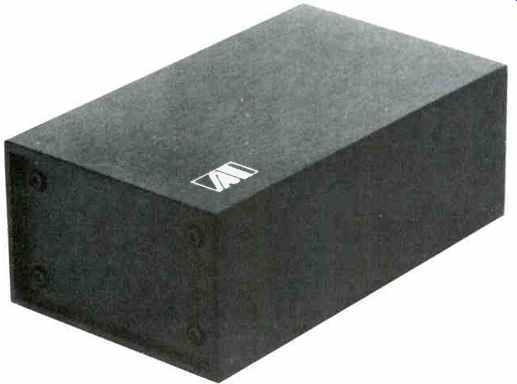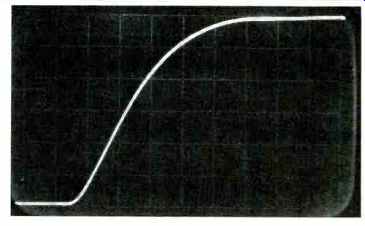
With the multitude of low-output moving-coil phono cartridges currently available
to the audiophile, there is need for an exceptionally good, yet moderately
priced step-up device with which to raise the low output from these phono cartridges
to a level suitable for the magnetic phono-input stage of a typical preamplifier.
Though many preamplifiers have input stages for moving-coil cartridges, I have
found that most of these built-in active devices (pre-preamplifiers) leave
much to be desired, because of their higher gain and noise, etc. It is rare
indeed to find a high-quality step-up device that does justice to a moving
coil phono cartridge and that is also available at a reasonable price. About
two years ago I became aware of such a device that was reasonably priced.
This unit is the Audio Interface CST-80, developed jointly by Dean Jensen and Anthony Suganuma, President of Audio Interface, exclusively for this firm. The CST-80 is available in either a 3-ohm or 40-ohm version, completely wired and tested, or as a kit at a lower price. The manufacturer's specifications are excellent, and my laboratory measurements verified the more important parameters. I did not assemble or test the kit versions.
-- ---- --- ---
Manufacturer's Specifications
Primary Source Impedance
Secondary Load Impedance
Turns Ratio Impedance
Ratio Input Impedance, @ 1 kHz
Secondary Source Impedance, @ 1 kHz
Voltage Gain Frequency Response, 20 Hz
Frequency Response, @ 20 kHz Bandwidth, @-3 dB
Phase Response, @ 20 Hz Phase Response, @ 20 kHz
Rise-Time (10% to 90%)
Overshoot Max. THD (Below Saturation)
Maximum Input Level, 1 %
Saturation (dBV re: 775 mV)
Transformer Noise Figure* 1.4 dB re: 2.7 ohms** | 1.7 dB re: 36.1 ohms**
*Referred to impedance of 4,720 ohms (CST-80L) or 4,935 ohms (CST-80H); parallel value of secondary impedance and load.
**Parallel value of source impedance and input impedance.
Prices: Wired, CST-80L (3-ohm version) or CST-80H (40-ohm version), $300.00; kit, CST-40L (3-ohm version) or CST-40H (4-ohm version), $220.00.
Company Address: P.O. Box 7369, Van Nuys, Cal. 91409.
-- ---- --- ---

Fig. 1--Square-wave rise-time, CST-80L (3-ohm version).
The CST-80 step-up transformer is of the non-toroidal type. It utilizes a precision split winding on a specially selected core material for a low-level signal. Although the construction itself is not unusual, Audio Interface uses a computer to aid in the design and production of the transformer. In design, all the parameters are determined by a combination of computer and extensive listening tests. In production, the essential parameters of every transformer, such as distortion, frequency response, phase response and gain, are checked and measured by a computer. Using these measurements, the individual transformers are then paired, thus assuring that both primary windings are identical and, similarly, both secondary windings are the same.
The transformer is built into a 5.1 x 2.0 x 3.0 inch (12.9 x 5.1 x 7.6 cm) rugged case of black anodized aluminum extrusion, and all the electronics are epoxy-encapsulated (potted) for extra durability. Because of this rugged construction, Audio Interface offers a five-year limited warranty to the original purchaser. The CST-80 is built with premium components throughout, including gold-plated phono connectors for minimum contact resistance.
Besides the input and output jacks, there is a ground terminal to which the turntable ground is attached. There are two versions of the transformer output available: The "E" model has phono output jacks, while the "D" model has a permanently attached, 1 meter output cable consisting of two shielded phono cables and a separate chassis ground wire. The output cable is a high-quality, low-capacitance type which minimizes frequency response degradation of low-level signals. The cable's high shield density guards against induced r.f. and electrostatic noise. The CST-80 transformer is immune to both induced noise or noise from the transformer itself. It is enclosed in a double mu-metal magnetic shield and a Faraday electrostatic shield plus an all-metal case which provides additional electrostatic shielding. This combination of shielding minimizes hum, noise, and r.f. interference. However, it is always wise to keep all transformers as far away as possible from any source of strong electromagnetic fields, including power-supply transformers and motors.
The output jacks or the output cables are connected directly to the standard magnetic phono inputs of the preamplifier. If the turntable is located too far from the rest of the system, it is recommended that the cables from the turntable to the transformer be extended, rather than the output cable from the transformer to the preamp.
However, the length of cable between the turntable and the transformer should not exceed 4 feet (1.3 meters). The Audio Interface CST-80 transformer is available in two impedance ranges; the CST-80L is a 3-ohm version for low impedance cartridges (3 to 5 ohms), and the CST-80H is a 40 ohm version for medium-high impedance cartridges (10 to 50 ohms). The 3-ohm version provides 30 dB of gain and matches the moving-coil cartridge output to the usual 47-kilohm phono input of the typical preamplifier. The 40-ohm version differs only in that it provides 20 dB of gain.
Like all transformers, the CST-80 requires neither an a.c. power source nor batteries inasmuch as it is a passive device. Because the moving-coil cartridge generates power rather than voltage, any such step-up device becomes a very important link between the moving-coil cartridge and the preamp. The CST-80 is ideal for this specific purpose, as it provides maximum energy transfer without degrading the sound of the moving-coil cartridge.
Measurements
In the laboratory, I measured the gain of the 3-ohm transformer as 30.5 dB and that of the 40-ohm version as 20 dB. This is sufficient gain for just about any moving-coil phono cartridge. I have not found a moving-coil phono cartridge that could overload this transformer at any audible frequency. The 1-kHz square wave is relatively flat on both the top and the bottom for both transformers. The 1 kHz square-wave rise-time (10% to 90%) is among the best I have ever measured, 3.3. µS left and 3.8 µS right channel for the 3-ohm version, while the 40-ohm version measured 2.7 µS left and 2.85 µS right channel. A typical square-wave rise-time oscilloscope picture is shown in Fig. 1. Frequency response for the 3-ohm version measured-1 dB at 20 Hz, 0 dB from 70 Hz to 25 kHz,-1 dB at 50 kHz,-3 dB at 90 kHz,-5 dB at 150 kHz, and-6.5 dB at 200 kHz. Frequency response for the 40-ohm version measured-1.5 dB at 20 Hz, 0 dB from 70 Hz to 40 kHz,-1 dB at 60 kHz,-3 dB at 100 kHz,-6 dB at 150 kHz, and-8 dB at 200 kHz. I was unable to induce hum in the transformers and concluded that the shielding was very effective. All in all, these are excellent data and certainly indicate both CST-80 transformers are of excellent quality.
Use and Listening Tests
I auditioned both Audio Interface CST-80 3-ohm and 40-ohm step-up transformers during the past 18 months with a variety of moving-coil phono cartridges. At no time was I able to discern any aural signal degradation due to either transformer. Neither transformer introduced any coloration or sound of its own, performing in all aspects as claimed by the manufacturer. I have found both transformers to be among the best step-up devices currently available for moving coil phono cartridges.
-B. V. Pisha
(Source: Audio magazine, Dec. 1982)
= = = =